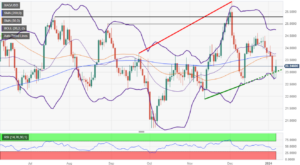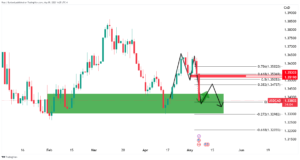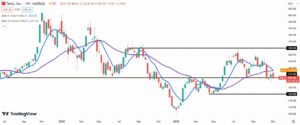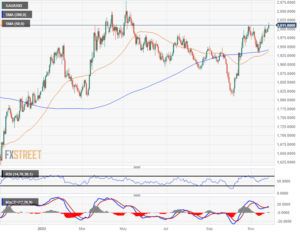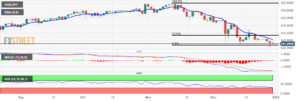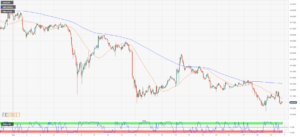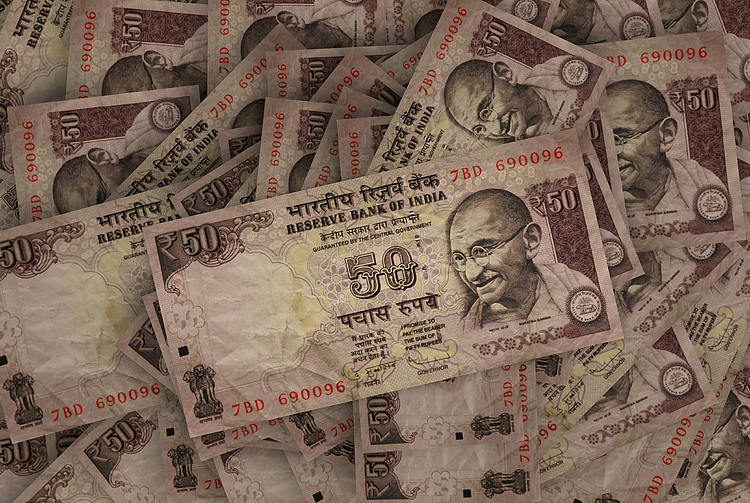
- Indian Rupee holds mild gains on a decline in US yields, US Dollar.
- The Federal Open Market Committee (FOMC) decided to hold the rate steady at its November meeting.
- The US Nonfarm Payrolls (NFP) will be closely watched later this week.
Indian Rupee posts modest gains on Thursday on lower US Treasury bond yields and the correction of the US Dollar (USD). The Federal Open Market Committee (FOMC) kept the federal funds rate unchanged at the 5.25-5.50% range at its November meeting on Wednesday, as widely expected. The Greenback edges lower as the markets anticipate that the US rate hike cycle is already over, despite Fed Chair Jerome Powell opening the door for another rate hike.
Nonetheless, the Indian Rupee remains sensitive to risk sentiment and global factors. The escalating tension in the Middle East and higher crude oil prices might contribute to the risk-off environment and cap the upside of the Indian Rupee. Investors will monitor the US weekly Initial Jobless Claims for the week ending October 27 on Thursday. The US Nonfarm Payrolls (NFP) will be in the spotlight on Friday.
Daily Digest Market Movers: Indian Rupee trades firmly amid the geopolitical risks
- The Reserve Bank of India (RBI) has appointed Mr Manoranjan Mishra as Executive Director.
- RBI announced the debut of the 'Inflation Expectations Survey of Households' and the 'Consumer Confidence Survey,' which would offer key inputs for the bi-monthly monetary policy.
- RBI Governor Shaktikanta Das said GDP growth for the second quarter of FY24 would surpass estimations.
- Geopolitical risks are the biggest challenge for India, but RBI Governor Das said India is better placed compared to other countries to deal with any potentially risky situation.
- Foreign investors sold $2.74 billion in Indian equities in October, marking the largest monthly sell-off since January 2023.
- The Federal Open Market Committee (FOMC) decided to hold the interest rate unchanged at its November meeting on Wednesday, as widely expected.
- The US Private Sector Payroll rose by 113K from 89K in September, below the 150k rise expected.
- US JOLTS Jobs Opening climbed to 9.553M, better than the estimation of 9.25M.
- The US ISM Manufacturing PMI dropped to 46.7 in October from the previous reading of 49.0, the lowest reading since July 2023.
Technical Analysis: Indian Rupee rebounds, upside potential seems limited
The Indian Rupee stages a modest recovery on the day. The USD/INR pair has traded within a familiar range of 83.00–83.35 since September. In the meantime, USD/INR keeps a bullish stance as the pair holds above the key 100- and 200-day Exponential Moving Averages (EMA) on the daily chart.
That being said, the key support level will emerge at the confluence of a low from October 24 and a round level marked at 83.00. A breach below 83.00 will see a drop to a low of September 12 at 82.82. Further south, the next contention level to watch is a low of August 4 at 82.65.
On the upside, the upper boundary of the trading range at 83.35 acts as an immediate upside barrier for the pair. Any decisive follow-through buying above the latter will pave the way to the year-to-date (YTD) highs of 83.45. The additional upside filter is located near a psychological round figure at 84.00.
US Dollar price in the last 7 days
The table below shows the percentage change of US Dollar (USD) against listed major currencies in the last 7 days. US Dollar was the weakest against the Australian Dollar.
| USD | EUR | GBP | CAD | AUD | JPY | NZD | CHF | |
| USD | -0.28% | -0.75% | 0.18% | -2.27% | 0.09% | -1.79% | 0.84% | |
| EUR | 0.28% | -0.47% | 0.45% | -1.99% | 0.35% | -1.51% | 1.13% | |
| GBP | 0.74% | 0.46% | 0.92% | -1.52% | 0.83% | -1.03% | 1.59% | |
| CAD | -0.17% | -0.46% | -0.93% | -2.46% | -0.08% | -1.97% | 0.68% | |
| AUD | 2.23% | 1.95% | 1.49% | 2.40% | 2.30% | 0.46% | 3.07% | |
| JPY | -0.08% | -0.33% | -0.82% | 0.11% | -2.37% | -1.90% | 0.76% | |
| NZD | 1.76% | 1.48% | 1.02% | 1.94% | -0.48% | 1.85% | 2.60% | |
| CHF | -0.86% | -1.14% | -1.62% | -0.68% | -3.15% | -0.76% | -2.67% |
The heat map shows percentage changes of major currencies against each other. The base currency is picked from the left column, while the quote currency is picked from the top row. For example, if you pick the Euro from the left column and move along the horizontal line to the Japanese Yen, the percentage change displayed in the box will represent EUR (base)/JPY (quote).
Indian Rupee FAQs
The Indian Rupee (INR) is one of the most sensitive currencies to external factors. The price of Crude Oil (the country is highly dependent on imported Oil), the value of the US Dollar – most trade is conducted in USD – and the level of foreign investment, are all influential. Direct intervention by the Reserve Bank of India (RBI) in FX markets to keep the exchange rate stable, as well as the level of interest rates set by the RBI, are further major influencing factors on the Rupee.
The Reserve Bank of India (RBI) actively intervenes in forex markets to maintain a stable exchange rate, to help facilitate trade. In addition, the RBI tries to maintain the inflation rate at its 4% target by adjusting interest rates. Higher interest rates usually strengthen the Rupee. This is due to the role of the ‘carry trade’ in which investors borrow in countries with lower interest rates so as to place their money in countries’ offering relatively higher interest rates and profit from the difference.
Macroeconomic factors that influence the value of the Rupee include inflation, interest rates, the economic growth rate (GDP), the balance of trade, and inflows from foreign investment. A higher growth rate can lead to more overseas investment, pushing up demand for the Rupee. A less negative balance of trade will eventually lead to a stronger Rupee. Higher interest rates, especially real rates (interest rates less inflation) are also positive for the Rupee. A risk-on environment can lead to greater inflows of Foreign Direct and Indirect Investment (FDI and FII), which also benefit the Rupee.
Higher inflation, particularly, if it is comparatively higher than India’s peers, is generally negative for the currency as it reflects devaluation through oversupply. Inflation also increases the cost of exports, leading to more Rupees being sold to purchase foreign imports, which is Rupee-negative. At the same time, higher inflation usually leads to the Reserve Bank of India (RBI) raising interest rates and this can be positive for the Rupee, due to increased demand from international investors. The opposite effect is true of lower inflation.
- SEO Powered Content & PR Distribution. Get Amplified Today.
- PlatoData.Network Vertical Generative Ai. Empower Yourself. Access Here.
- PlatoAiStream. Web3 Intelligence. Knowledge Amplified. Access Here.
- PlatoESG. Carbon, CleanTech, Energy, Environment, Solar, Waste Management. Access Here.
- PlatoHealth. Biotech and Clinical Trials Intelligence. Access Here.
- Source: https://www.fxstreet.com/news/usd-inr-posts-modest-losses-as-fed-maintains-status-quo-202311020247
- :has
- :is
- $UP
- 1
- 12
- 2023
- 24
- 27
- 32
- 35%
- 41
- 46
- 49
- 65
- 7
- 84
- 9
- a
- above
- actively
- acts
- addition
- Additional
- adjusting
- against
- All
- along
- already
- also
- Amid
- an
- analysis
- and
- Animate
- announced
- Another
- anticipate
- any
- appointed
- ARE
- AS
- At
- AUGUST
- Australian
- Australian dollar
- Balance
- Bank
- Bank of India
- barrier
- base
- BE
- being
- below
- benefit
- Better
- Biggest
- Billion
- bond
- Bond yields
- borrow
- Box
- breach
- Bullish
- but
- Buying
- by
- CAN
- cap
- Chair
- challenge
- change
- Changes
- Chart
- claims
- Climbed
- closely
- Column
- committee
- comparatively
- compared
- conducted
- confidence
- confluence
- consumer
- content
- contribute
- Cost
- countries
- country
- crude
- Crude oil
- currencies
- Currency
- cycle
- daily
- day
- Days
- deal
- debut
- decided
- decisive
- Decline
- Demand
- dependent
- Despite
- Devaluation
- difference
- Digest
- direct
- Director
- displayed
- Dollar
- Door
- Drop
- dropped
- due
- each
- East
- Economic
- Economic growth
- effect
- EMA
- emerge
- ending
- ends
- Environment
- Equities
- especially
- Ether (ETH)
- EUR
- Euro
- eventually
- example
- exchange
- Exchange rate
- executive
- Executive Director
- expanded
- expectations
- expected
- exponential
- exports
- external
- facilitate
- factors
- familiar
- FAQ
- Fed
- Fed Chair
- Federal
- Federal Funds Rate
- Federal Open Market Committee
- Figure
- filter
- firmly
- FOMC
- For
- foreign
- foreign investment
- forex
- Forex markets
- Friday
- from
- funds
- further
- FX
- FX markets
- Gains
- GDP
- gdp growth
- generally
- geopolitical
- Global
- Governor
- greater
- Greenback
- Growth
- help
- higher
- highly
- Highs
- Hike
- hold
- holds
- Horizontal
- households
- HTTPS
- if
- immediate
- imports
- in
- include
- increased
- Increases
- india
- Indian
- inflation
- Inflation expectations
- inflation rate
- inflows
- influence
- influencing
- Influential
- initial
- inputs
- interest
- INTEREST RATE
- Interest Rates
- International
- international investors
- intervention
- investment
- Investors
- IT
- ITS
- January
- Japanese
- Japanese Yen
- jobless claims
- Jobs
- jpg
- July
- Keep
- kept
- Key
- largest
- Last
- later
- lead
- leading
- Leads
- left
- less
- Level
- Line
- Listed
- located
- losses
- Low
- lower
- lowest
- maintain
- maintains
- major
- manufacturing
- map
- marked
- Market
- Markets
- marking
- meantime
- meeting
- Middle
- Middle East
- might
- mild
- Mishra
- modest
- module
- Monetary
- Monetary Policy
- money
- Monitor
- monthly
- more
- most
- move
- Movers
- moving
- moving averages
- mr
- Near
- negative
- next
- nfp
- Nonfarm
- Nonfarm Payrolls
- November
- october
- of
- offer
- offering
- Oil
- on
- ONE
- open
- opening
- opposite
- Other
- over
- overseas
- pair
- particularly
- pave
- Payroll
- Payrolls
- peers
- percentage
- pick
- picked
- Place
- placed
- plato
- Plato Data Intelligence
- PlatoData
- pmi
- policy
- positive
- Posts
- potential
- potentially
- previous
- price
- private
- private sector
- Profit
- psychological
- purchase
- Pushing
- Quarter
- quote
- raising
- range
- Rate
- Rate Hike
- Rates
- RBI
- Reading
- real
- recovery
- reflects
- relatively
- remains
- represent
- Reserve
- reserve bank
- Reserve Bank of India
- Rise
- Risk
- risks
- Risky
- Role
- ROSE
- round
- ROW
- Said
- same
- Second
- second quarter
- sector
- see
- seems
- sell-off
- sensitive
- sentiment
- September
- set
- Shows
- since
- situation
- So
- sold
- South
- Spotlight
- stable
- stages
- stance
- starts
- Status
- steady
- Strengthen
- stronger
- support
- support level
- surpass
- Survey
- table
- Target
- than
- that
- The
- The Reserve Bank of India
- their
- this
- this week
- Through
- thursday
- time
- to
- top
- trade
- traded
- trades
- Trading
- treasury
- true
- Upside
- us
- US Dollar
- US ISM Manufacturing
- US ISM Manufacturing PMI
- US nonfarm payrolls
- US nonfarm payrolls (NFP)
- US Treasury
- US yields
- USD
- usd/inr
- usually
- value
- was
- Watch
- Way..
- Wednesday
- week
- weekly
- WELL
- which
- while
- widely
- will
- with
- within
- would
- Yen
- yields
- you
- zephyrnet

